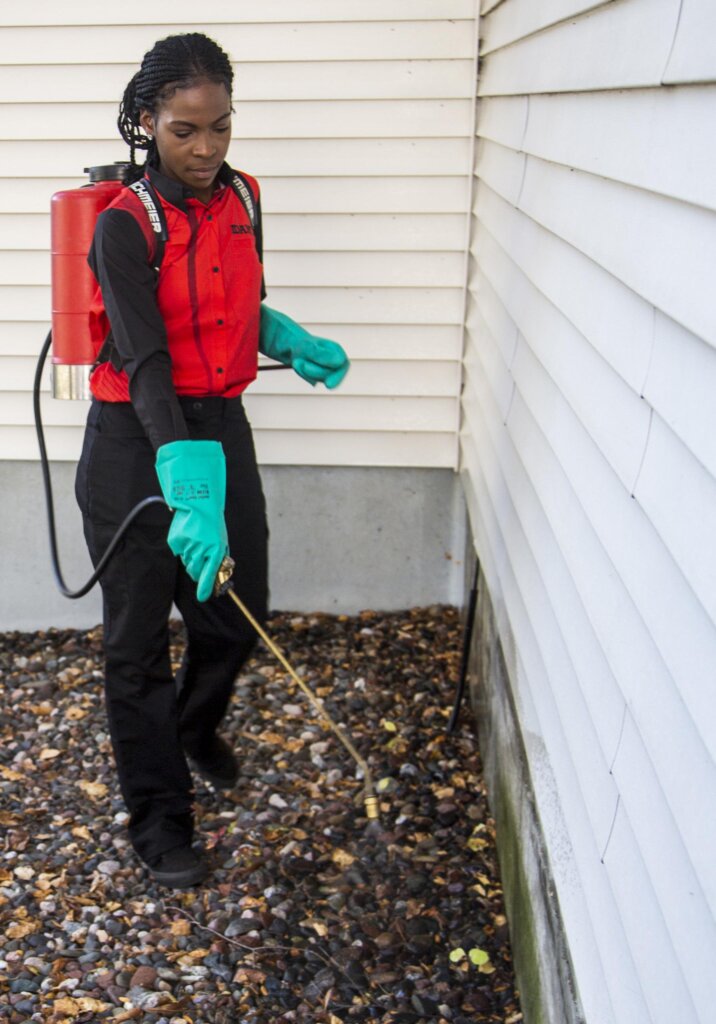Specialist A1 Charlotte Bed Bug Exterminator - Top Quality Solution Assured
Specialist A1 Charlotte Bed Bug Exterminator - Top Quality Solution Assured
Blog Article
Bed Insect Treatment Failure: Comparing Chemical Vs. Non-Chemical Solutions
In the world of parasite control, particularly when dealing with the consistent issue of bed pests, the choice in between chemical and non-chemical treatment solutions can be an essential one. Both approaches use distinct benefits and drawbacks, influencing aspects such as performance, security factors to consider, and total cost. By analyzing the nuanced details of each approach, a more clear understanding of which course to pursue in resolving a bed pest infestation can be acquired.
Performance of Chemical Therapies
Chemical treatments for bed insect infestations have actually been extensively acknowledged for their fast and potent efficiency in eliminating these bugs. When taking into consideration the efficiency of chemical treatments, it is important to comprehend that they can provide a quick and thorough solution to a bed insect trouble. Professional pest control operators commonly depend on insecticides to target bed bugs at numerous phases of their life process, including eggs, grownups, and fairies. These chemicals commonly function by interfering with the bed bugs' nerves, causing paralysis and ultimate death.
Additionally, chemical treatments have the advantage of offering residual impacts, implying that they can remain to get rid of bed bugs also after the preliminary application. This residual activity is especially useful in combating any possible re-infestations. Furthermore, the fast activity of chemical therapies can bring relief to individuals facing extreme bed bug infestations, allowing them to reclaim control of their home quickly.
Security Worries With Chemical Solutions
One critical facet that calls for mindful factor to consider when utilizing chemical services for bed bug treatment is making certain the security of residents and the environment. Exposure to specific chemicals made use of in bed bug therapies can lead to respiratory system concerns, skin irritability, or various other adverse reactions, especially in individuals with pre-existing conditions or sensitivities.
In addition, the environmental impact of chemical solutions is one more significant consideration. Some pesticides used in bed bug treatments may be hazardous to helpful pests, wildlife, and ecosystems if they seep into the soil or water systems. It is important to use chemical therapies carefully, complying with safety and security standards, and considering less poisonous alternatives to minimize these threats and guarantee the secure and reliable monitoring of bed bug invasions.
Benefits of Non-Chemical Strategies
Considering the prospective safety and security issues and environmental effect linked with chemical services for bed pest treatment, discovering non-chemical methods provides an encouraging alternative with numerous distinctive benefits. Non-chemical therapies are eco friendly, as they do not add to air or water contamination, making them a sustainable selection for pest control.
In addition, non-chemical remedies can be effective in targeting bed insects, including hard-to-reach locations where chemical therapies may not permeate - A1 charlotte bed bug exterminator. Techniques such as heat therapy, vacuuming, heavy steam cleaning, and bed mattress encasements supply comprehensive elimination without the use of damaging chemicals.
Limitations of Non-Chemical Treatments

Furthermore, non-chemical treatments frequently need numerous applications to achieve effective obliteration. This click here for more info can be taxing and may not constantly ensure complete removal of all bed insects and their eggs, especially in covert or hard-to-reach places.
Furthermore, the success of non-chemical treatments heavily depends on correct implementation and thoroughness, which can be testing for people without expert expertise. Insufficient application of non-chemical approaches might cause insufficient obliteration, bring about consistent invasions and the demand for added therapies.
As a result, while non-chemical therapies have their advantages, it is essential to acknowledge these constraints and consider them when determining the most reliable method for taking care of bed bug infestations.
Cost Contrast: Chemical Vs. Non-Chemical Options
Provided the limitations connected with non-chemical treatments, a necessary element to assess in the context of bed bug monitoring is the cost comparison between chemical and non-chemical choices. Chemical treatments generally include the application of insecticides by experts, which can vary from $250 to $900 per room, relying on the extent of the invasion and the dimension of the location to be treated. On the other hand, non-chemical therapies like heat informative post treatment or vapor can be extra costly, with costs ranging from $1,000 to $6,000 for a whole home. While the preliminary price of chemical treatments may appear reduced, numerous treatments may be needed to completely eradicate the invasion, possibly enhancing the total cost. On the other hand, non-chemical alternatives might give a more lasting and green service, although they can be cost-prohibitive for some individuals. Eventually, when considering the expense of bed bug treatment alternatives, it is very important to evaluate the upfront expenses versus the efficiency and long-lasting sustainability of the picked method.
Conclusion

Considering the possible security issues and ecological impact linked with chemical solutions for bed bug treatment, checking out non-chemical strategies presents a promising choice with numerous distinctive benefits.Given the restrictions see here associated with non-chemical treatments, a crucial aspect to review in the context of bed pest monitoring is the price contrast between chemical and non-chemical choices. In contrast, non-chemical treatments like warmth therapy or steam can be more costly, with prices ranging from $1,000 to $6,000 for a whole home. While the first cost of chemical therapies may appear reduced, several therapies might be called for to completely eradicate the invasion, possibly enhancing the overall price.In conclusion, when comparing chemical and non-chemical bed insect therapy choices, it is necessary to take into consideration efficiency, security, advantages, limitations, and expense.
Report this page